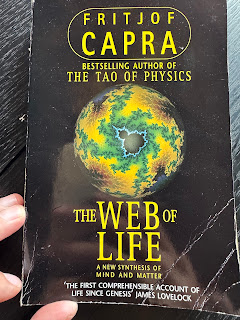This passage Fritjof Capra’s 1997 feels book relevant to our time.
“ A NEW DIALOGUE WITH NATURE
The conceptual shift implied in Prigogine's theory involves several closely interrelated idcas. The description of dissipative structures that exist far from equilibrium requires a nonlinear mathematical formal-ism, capable of modelling multiple interlinked feedback loops. In living organisms, these are catalytic loops (i.c. nonlinear, irreversible chemical processes) which lead to instabilities through repeated self-amplifying feedback. When a dissipative structure reaches such a point of insta bility, called bifurcation point, an element of indeterminacy enters into the theory. At the bifurcation point the system's behaviour is inherently unpredictable. In particular, new structures of higher order and complexity may emerge spontaneously. Thus self-organization, the spontaneous emergence of order, results from the combined effects of non-equilibrium, irreversibility, feedback loops, and instability.
The radical nature of Prigogine's vision is apparent from the fact that these fundamental ideas were rarely addressed in traditional science and were often given negative connotations. This is evident in the very language used to express them. Nonequilibrium, nonlinearity, instability, indeterminacy, etc., are all negative formulations. Prigogine believes that the conceptual shift implied by his theory of dissipative structures is not only crucial for scientists to understand the nature of life but will also help us to integrate ourselves more fully into nature.
Many of the key characteristics of dissipative structures - the sensitivity to small changes in the environment, the relevance of previous history at critical points of choice, the uncertainty and unpredictability of the future - are revolutionary new concepts from the point of view of classical science, but are an integral part of human experience. Since dissipative structures are the basic structures of all living systems, including human beings, this should perhaps not come as a great surprise.
Instead of being a machine, nature at large turns out to be more like human nature - unpredictable, sensitive to the surrounding world, influenced by small fluctuations. Accordingly, the appropriate way of approaching nature to learn about her complexity and beauty is not through domination and control but through respect, cooperation, and dialogue. Indeed, Ilya Prigogine and Isabelle Stengers gave their popular book, Order out of Chaos, the subtitle 'Man's New Dialogue with Nature'
In the deterministic world of Newton, there is no history and no creativity. In the living world of dissipative structures, history plays an important role, the future is uncertain, and this uncertainty is at the heart of creativity. "Today, Prigogine reflects, "the world we see outside and the world we see within are converging. This convergence of two worlds is perhaps one of the important cultural events of our age.”
And the last page of the book:
“ In ecosystems, the role of diversity is closely connected with the system's network structure. A diverse ecosystem will also be resilient, because it contains many species with overlapping ecological functions that can partially replace one another. When a particular species is destroyed by a severe disturbance so that a link in the network is broken, a diverse community will be able to survive and reorganize itself, because other links in the network can at least partially fulfil the function of the destroyed species. In other words, the more complex the network is, the more complex its pattern of interconnections, the more resilient it will be.
In ecosystems, the complexity of the network is a consequence of its biodiversity, and thus a diverse cological community is a resilient community. In human communities, ethnic and cultural diversity may play the same role. Diversity means many different relationships, many different approaches to the same problem. A diverse community is a resilient community, capable of adapting to changing situations.
However, diversity is a strategic advantage only if there is a truly vibrant community, sustained by a web of relationships. If the community is fragmented into isolated groups and individuals, diversity can easily become a source of prejudice and friction. But if the community is aware of the interdependence of all its members, diversity will enrich all the relationships and thus enrich the community as a whole, as well as each individual member. In such a community information and ideas flow freely through the entire network, and the diversity of interpretations and learning styles - even the diversity of mistakes - will enrich the entire community.
These, then, are some of the basic principles of ecology - interdepen-dence, recycling, partnership, flexibility, diversity, and, as a consequence of all those, sustainability. As our century comes to a close and we go towards the beginning of a new millennium, the survival of humanity will depend on our ecological literacy, on our ability to understand these principles of ecology and live accordingly.”

No comments:
Post a Comment